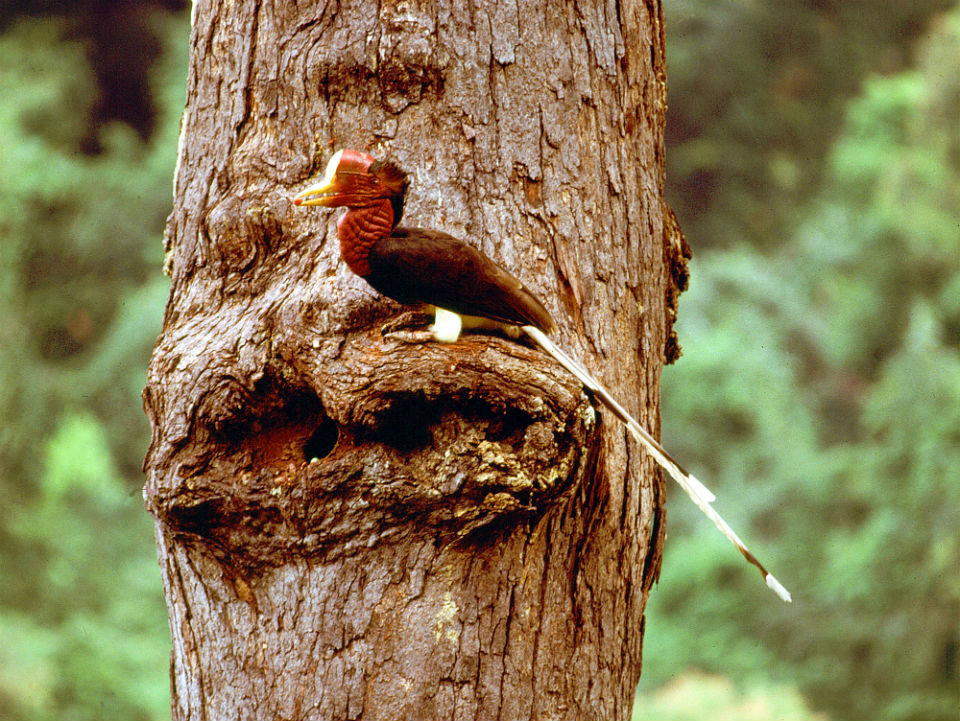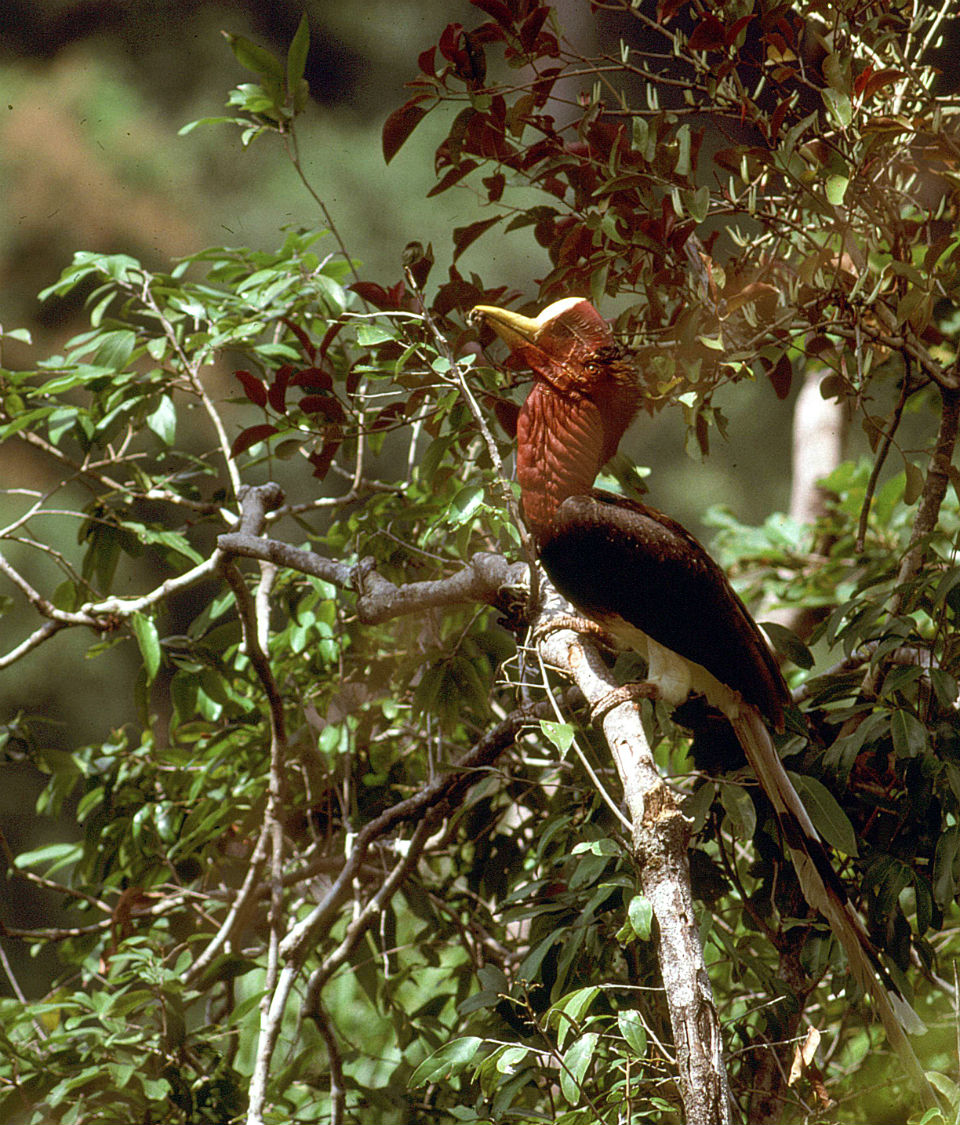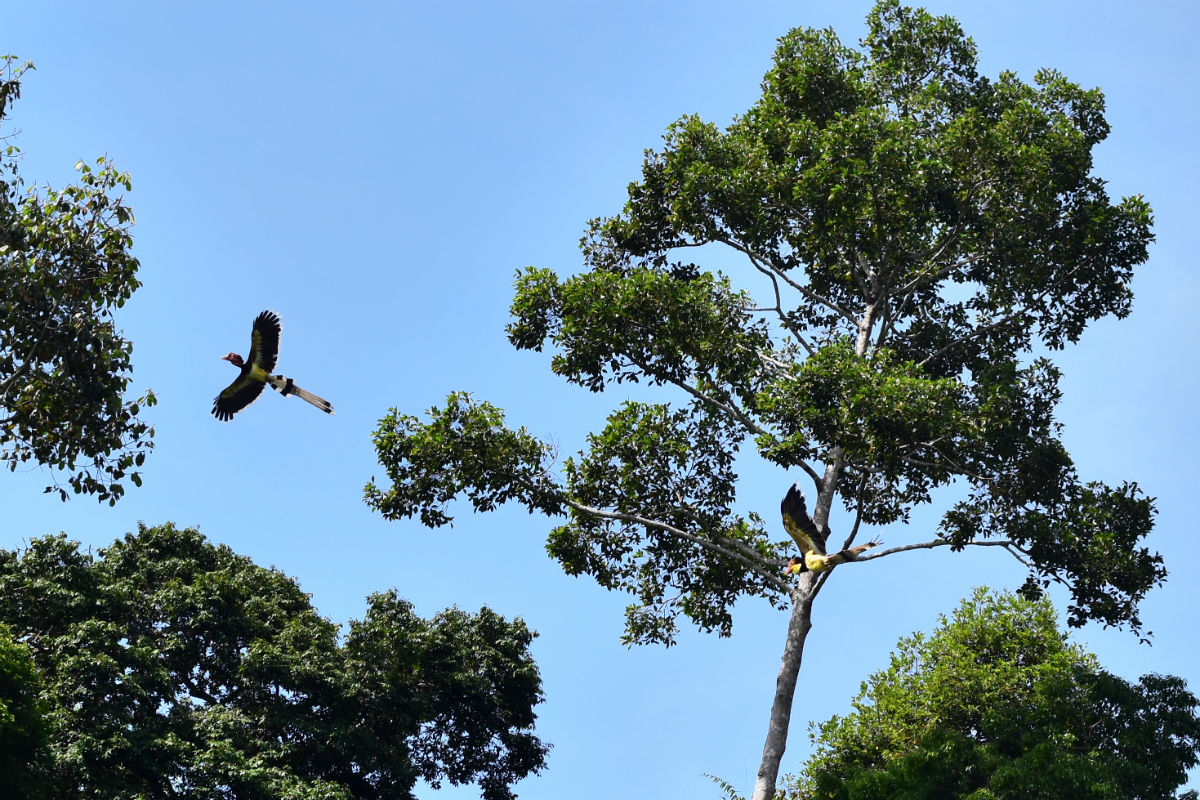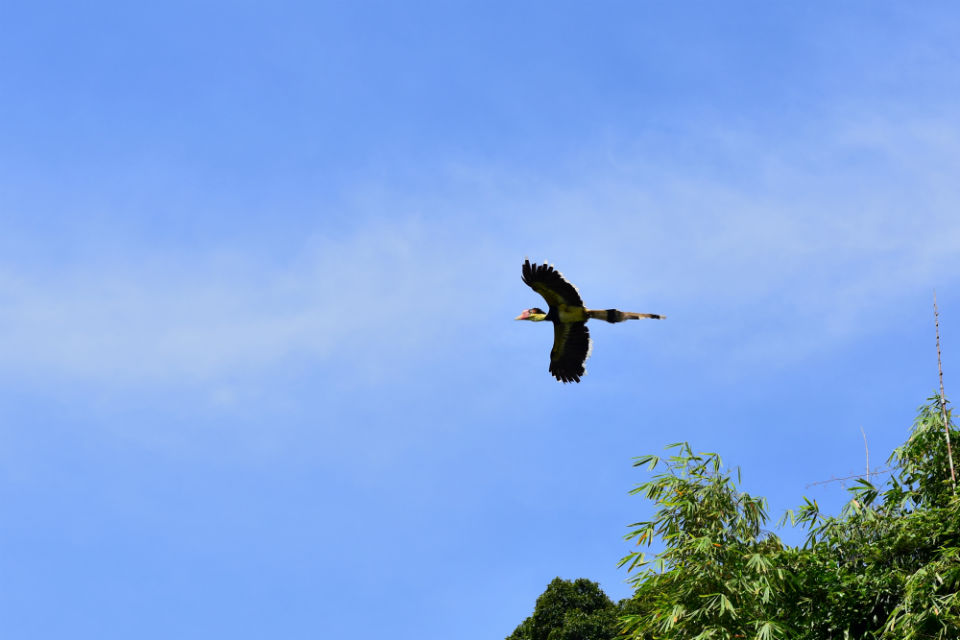Helmeted Hornbill ( Rhinoplax vigil Monotypic. )
Placed in a genus of its own due to unique morphology and vocalization, but a sister species to Buceros hornbills and has also been included in that genus.
Placed in a genus of its own due to unique morphology and vocalization, but a sister species to Buceros hornbills and has also been included in that genus.

Size 110-127 cm. Male 3060 g; female 2610-2840 g. Very large hornbill with characteristic elongated central tail feathers of extra 30-45 cm; wings with creamy-white trailing edge. The relatively short bill and front of a high red casque are cosmetically stained with yellow from preen oil.
Male has bare red neck. The heavy anterior casque is solid ‘ivory’. The female is smaller with pale bluish skin on neck and smaller casque. Juvenile has shorter tail, small yellow bill with low casque and light greenish-blue head and neck.
The voice of the male is a unique call that can be heard over 2 km away; it is one of the distinguishing sounds of undisturbed Sundaic rainforest .
The male positions himself high in the forest; the call starts as a series of slow deep honking notes, in the beginning far apart; then the notes build up gradually in speed, before climaxing in loud maniacal laughter.
Bouts of penetrating calls like this, with a few minutes interval, can last for one hour; the female will sometime join it in a duet, her pitch a bit higher.
Found in large expanses of primary Sundaic rainforest; extends into adjacent closed secondary forest. Seemingly prefers hilly terrain away from the coast, often at 300-1,100 m elevation,occasionally to 1,50o m. It is shy and wary and rarely comes to the forest edges, preferring remote and rugged terrain.
The food is mainly fruits especially many fig species. In southern Thailand, besides figs, other dominant fruits recorded are in families Annonaceae (Polyalthia ), Meliaceae (Aglaia ,Dysoxylum ), Arecaceae ( Oncosperma horridum ),Lauraceae ( Litsea ) and Myristicaceae ( Horsfieldia Myristica ).
Throughout its range this is the hornbill with the most specialized diet; surveys in both Borneo, Sumatra and southern Thailand have never been able to identify more than 6-7 different fruit tree species as food, compared to a minimum of 16 (Wrinkled Hornbill) and maximum 93 (Bushy-crested Hornbill), for other sympatric hornbills.
Surveys of Helmeted Hornbill have shown that it spends about half the day actively hunting animal prey, including rodents and nestlings, even smaller sympatric hornbill species.
It moves about high in large nest trees and is surprisingly quick and agile chasing down prey; probes into bark and with its short, strong bill. It is a bit of a loner, and even a pair will split up and feed separately within their home range.
Largely territorial and sedentary; males and females have been observed banging the solid casques together, often in fight presumably in status or territorial disputes.
Aerial jousting is not uncommon but jousting to death is rare. It will fly far across the forest to visit good fruiting trees and will mix and other hornbills while feeding; outside of the breeding season up to 27 birds have been reported together.
Local villagers regard the trespassing of this bird as an omen of good crop production.



One nest in Peninsular Malaysia at 800 m elevation was 30 m off the ground. The female seals the nesting hole with mud and food pulp brought in by the male; the floor is lined with wood chips; in one Malaysian survey the sealing lasted 13-14 days, the female staying confined inside the nest after 9 days of work on this.
The clutch is 1-2 eggs; the male will feed the female and later a chick inside the nest with regurgitated food and with small animals that it holds in its bill; it will bring 10-113 fruits per visit. Only one chick reported to fledge; exact incubation and nesting period unknown, but suspected to be slightly longer than Great Hornbill.
A female was observed in the nest with a chick 146 days after her confinement and is believed to leave the nest with the chick. The average entire nesting cycle is 160 days (range 154-167 days, once 183 days). This species is difficult to keep in captivity, therefore not surprising no success at captive breeding has ever been reported.
Since it requires a very specific feature of the nest it is difficult to repopulate once the population has declined.
The nesting season is largely aseasonal; egg-laying has been recorded in Jan-Mar, May and Nov; on Sumatra nesting starts from Jan to Aug and from Nov to Mar.
In southern Thailand, 87% of nest are found in trees of Dipterocapaceae, including Hopea, Shorea and Neobalancarpus. Average of tree size (DBH), tree height and nest height above the ground are 160 cm, 42 m and 30 m, respectively; female seals in Mar and a chick fledges in July.
The nest is a natural cavity in a big tree deep inside the forest, in particular the cavity is very characteristic with a ledge above on which the male can land and perch with its relatively heavy head and short legs while it feeds the female and chick.